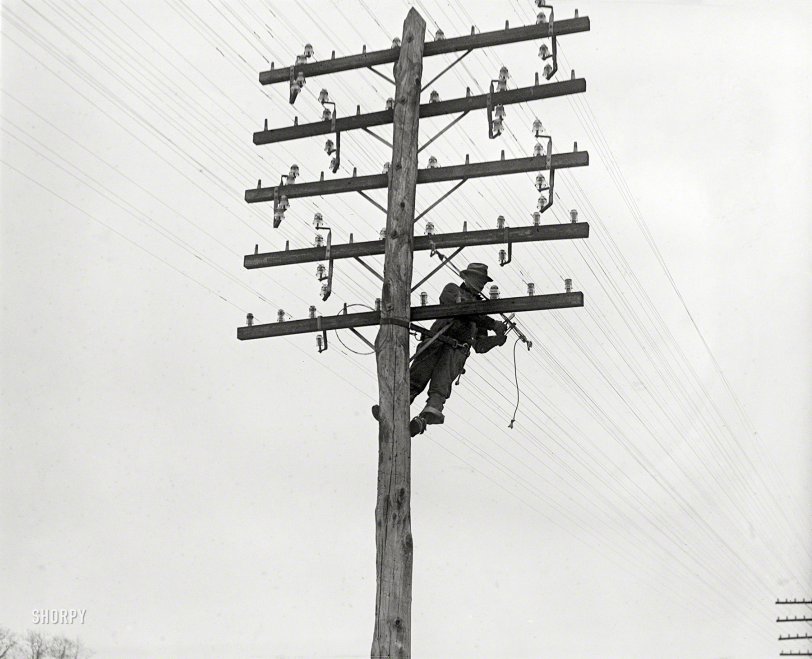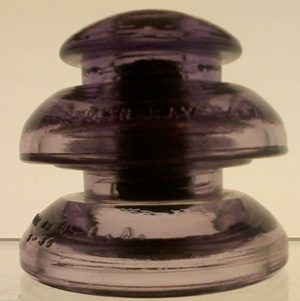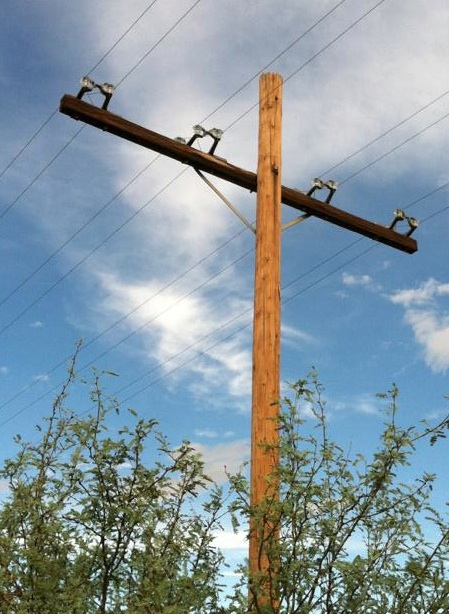


Framed or unframed, desk size to sofa size, printed by us in Arizona and Alabama since 2007. Explore now.
Shorpy is funded by you. Patreon contributors get an ad-free experience.
Learn more.

- Recent view
- Hudson’s Big Store
- Say what??
- Grapes?!
- A Beautiful Moment
- Such joy
- Bethune-Cookman University today...
- Yellow sky at morning
- Side Winder
- Air Quality?
- Sojourner Truth riot
- None were so blind(ed)
- The less famous sister
- Good ol' days?
- Rise and Fall
- Goo Goo Ga Joob
- Ticket Retention
- Not the only one
- Vagaries of War
- Killed by Amtrak
- Back to the Future
- Wanted --
- If you can't stand the light
- Centralized Traffic Control, I believe
- What's really happening
- Heckuva remote control!
- Sometimes — Things Go Bump!
- I SEE THE LIGHT
- Union Switch and Signal Company
- Get That Light Out Of My Eyes
Print Emporium
A Higher Calling: 1929

Washington, D.C., 1929. "Chesapeake & Potomac Telephone Co. lineman." National Photo Company Collection glass negative. View full size.
Pole Linesman School
A long time ago (1950s)I was at Camp (now Fort) Gordon outside of Augusta, GA which had signal corps schools. One of them was for future linesmen. To support their training, there was a decent sized field with nothing put poles for them to learn to climb on. After an unnumbered soldiers had climbed up and down on them they were, to say the least, covered in splinters. One did not want to loose their footing and slide down the pole.
Rolled up pant cuffs; a fedora and a set of 'slack blocks'
I'm long retired from the electric utility business although this crusty old timer brings back memories of a simpler time. The pant cuffs were almost always rolled up a little to keep the wearer from an adverse tightening in all the wrong places while climbing and moving about on the pole. The pant legs were then pulled UP slightly while strapping on his "hooks" or climbers; then the body belt and safety strap (often called the scare strap) combination was strapped on around the hips....NOT the waist.
He is apparently, in the business of installing or repairing a conductor as he is using a set of slack blocks (small block and tackle) with a wire grip or 'come-along' on one end of the slacks. The other end has a strong steel hook which can be attached around a piece of hardware as to have a place to pull against and tension the wire before splicing.
Transposition
This is also used in three-phase transmission lines to equalise capacitance to earth...
Transposition insulators
Bottom row, 3rd from the right is a tramp [trade name] insulator. A two piece to be exact. I would love to know the color of it. The one in my collection shaped like that one happens to be a rich green, and it took several years to find a top and bottom in decent shape. Pictured is my purple two piece tramp. Believe it or not, these are found in a lot of collections.

Phantom Circuits
Phantom circuits were derived by tapping the repeat coils of two open wire circuits. This was accomplished in the central office. The open wire pairs used for phantom circuits were no different on the poles than non-phantom circuits. This innovation occurred sometime prior to 1916.
Bucket trucks need not apply
I wonder if any linemen still climb the poles with spurs and a leather belt.
nixiebunny's photo
nixiebunny's like has carrier systems (or maybe PGCUs) rather than voice or telegraph.
High tension
Look at all the splices and note how the lineman appears to be making yet another one. Maybe they stretched the wires a bit too tightly.
1929 Lineman Safety Meeting Transcript::
"Be careful up there, Joe."
More Brackets
OldeRadio is correct. In the picture, though, are some brackets which support three wires (plus the one on the crossarm, for a total of four). This suggests that "phantom" circuits are used here. Obviously, a pair of wires is one circuit, and must be "twisted" to reduce crosstalk. A "phantom" circuit used the two wires of one pair for one side of the "circuit", and the two wires of another pair for the other side. Thus, four wires could carry three circuits, with no wire common to any of them. The four wires would also have to be "twisted" in the same manner; hence, the larger brackets here.
Transposition Insulators
are what they are called. Railroad telephone and telegraph poles also incorporate the same arrangement.
It still exists here and there
There's a couple miles of four-pair open line on Arizona highway 86 west of Tucson, just east of the Border Patrol checkpoint. It has a different style of bracket for the twisted pairs.
I like to think of it as a Claes Oldenburg version of an Ethernet cable.

Brackets
Selected pairs are rotated, or twisted, to reduce crosstalk. There is always some mutual coupling between the wires; by twisting them the adjacent wires alternate a few times in a mile to help cancel the coupling between pairs. If you folow the lines for several miles you'll see that each pair gets a half-twist every half mile or so. In multipair cables the pairs are twisted fairly tightly for the same reason, and color coded for identification.
Why the Brackets?
When I was a boy growing up in northwest Ohio, we often drove Route 53 between Fremont and Tiffin. This picture was repeated countless times until underground cable was installed circa 1965.
One thing I always wondered -- and still do -- is why some of the insulators were mounted on descending metal brackets and not on the horizontal crosspieces as the others were?
























On Shorpy:
Today’s Top 5